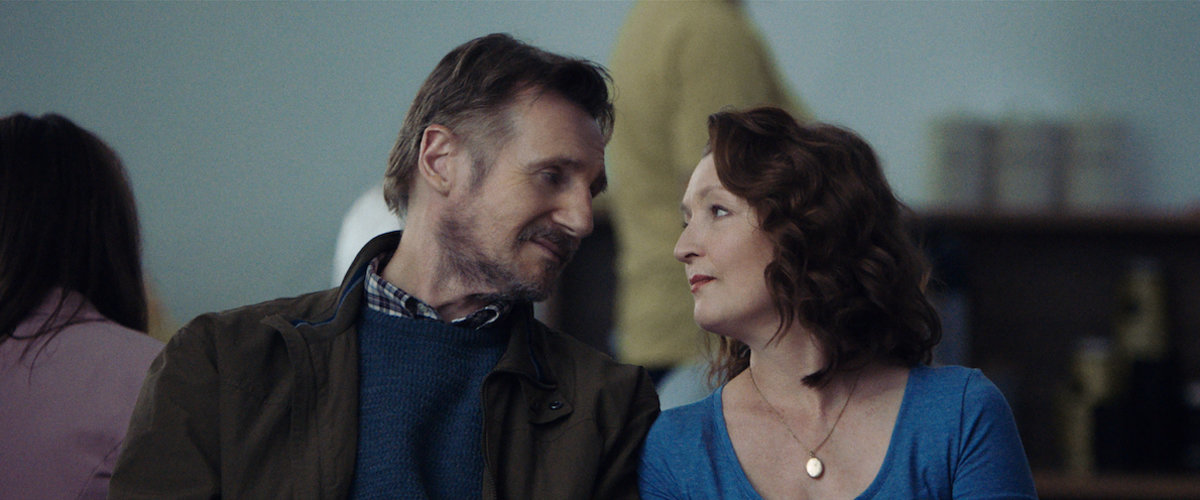“Ordinary Love” – “If you have a friend or family member with breast cancer, try not to look at her with sad eyes. Treat her like you always did; just show a little extra love.” – Hoda Kotb
Joan (Lesley Manville) and Tom (Liam Neeson) have stable, healthy lives, but not ordinary ones. In their 60s, they lounge around their spacious home – that sports a 40-year-old décor – in suburban Belfast. This longtime husband and wife spend their days and nights with one another, as they relish brisk walks along River Lagan, take trips to the grocery store and share every meal. Neither Joan or Tom ever bring up money, and retirement appears to be their pleasant reality.
Now, according to Google, the definition of ordinary is with no special or distinctive features; normal; uninteresting; commonplace. With a coin flip accurately estimating the chance of a marriage’s survival, and many couples absolutely depending on their paychecks to get them through the week, Joan and Tom are enjoying their comfortable, satisfying days.
Director Lisa Barros D’Sa and Glenn Leyburn and writer Owen McCafferty (who wrote this screenplay based on his own marriage), however, disrupt Joan and Tom’s routines and security, when she contracts breast cancer. Now, this loving, supportive couple – who yes, sometimes include bickering with their banter – face a potential death sentence.
At the moment, the final verdict remains unknown.
Without flashy gimmicks or fanfare, D’Sa and Leyburn simply lay out this distressed couple’s new tasks, in which doctor appointments and hospital visits become commonplace events. In a way, sterile medical facilities have developed into Joan and Tom’s collective second home. The filmmakers establish this parallel by flashing shots of several empty rooms within the couple’s house during the movie’s opening minutes. Later, the audience is forced to endure long sequences in clinical spaces with bulky equipment or full waiting rooms that reek with anxiety, as two celebrated actors carry Joan and Tom on their journey.
Manville – a highly-skilled authority at portraying rich and complex supporting characters, including her Oscar-nominated turn in “Phantom Thread” (2017) and a heaping stack of work for director Mike Leigh in “Secrets & Lies” (1996), “Vera Drake” (2004) and “Another Year” (2010), to name a few – bravely delivers an authentic, raw performance as a vulnerable woman facing the abyss…and chemotherapy. D’Sa and Leyburn don’t pull any punches, as they drag Joan through every fear, troubling thought, medical procedure, and moment of despair that a breast cancer patient may endure.
It’s tough to watch. Not “Lorenzo’s Oil” (1992)-tough, but still terribly challenging.
Luckily, Tom is by her side. Neeson delivers a welcome mix of tenderness, vulnerability and fortitude but also hints at (and outright exclaims) their marital troubles, ones partially-buried below accumulated layers of daily pleasantries, chores and occasional glasses of wine. Quite refreshingly, Neeson takes a temporary break from the “Taken” series and other mindless celluloid nonsense where he guns down massive quantities of drug dealers, kidnappers and sick baddies. Here, Neeson’s Tom churns through choppy life-seas and quietly turns inward to find his way.
Personal, introspective cancer stories frequent the silver screen, but often times, they star young actors and look to “50/50” (2011) and “The Fault in Our Stars” (2014) as recent examples. When cancer strikes someone in the prime of their life, a deeper layer of heartbreak surely intensifies the narrative. Geez, just try to hold back the tears during the third act of “Me and Earl and the Dying Girl” (2015). This critic isn’t that strong.
For Joan, in the third act of life, her reality is dire, as Tom and she attempt to inoculate the anguish for revealing their sad eyes to each other.
⭐⭐⭐ out of ⭐⭐⭐⭐
Image credits: Focus Features; Trailer credits: Bleecker Street




